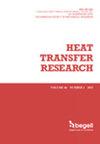利用混合纳米流体改善光伏/热(PV/T)系统的热发电性能
IF 1.6
4区 工程技术
Q3 THERMODYNAMICS
引用次数: 0
摘要
太阳能是一种安全、清洁的能源,在地球上一年四季都可以使用。PV/T系统是一种将太阳能转化为电能/热能的装置。光伏/热(PV/T)系统也可用于生产热流体(通常是水)以及产生电能。此外,光伏发电性能随着热系统放热能力的提高而提高,这也可以防止光伏系统过热。纳米流体是新一代传热流体,与传统流体相比,具有更高的导热性和传热速率。纳米流体的导热性取决于纳米颗粒的大小、纳米流体的浓度及其制备方法。在这项研究中,其目的是通过使用混合纳米流体来增加PV/T系统的热传递,混合纳米流体是通过在水中添加0.5%的Fe2O3和Fe3O4纳米颗粒作为工作流体制成的。通过使用混合纳米流体,可以提高双向性能并增强冷却效果。在实验研究中,利用混合纳米流体的高导热性,可以将更多的热量从加热后的光伏板中抽出,并且混合纳米流体的总效率提高了86%。在冷却回路中使用混合纳米流体,光伏板的电效率和热效率总体平均达到81%。本文章由计算机程序翻译,如有差异,请以英文原文为准。
Improving Thermal and Electricity Generation Performance of Photovoltaic/Thermal (PV/T) Systems Using Hybrid Nanofluid
Solar energy is a safe and clean source of energy, available on earth throughout the year. A PV/T system is a device designed to take solar energy and convert it into electrical/thermal energy. Photovoltaic/Thermal (PV/T) systems can also be useful to produce hot fluid (usually water) along with the generation of electrical energy. In addition, the electric generating performance of PVs increases with heat discharging ability of thermal system, which also prevent overheating in PV systems. Nanofluid is a new generation heat transfer fluid that deliver higher thermal conductivity and heat transfer rate compared to conventional fluids. The thermal conductivity of the nanofluid depends on the size of the nanoparticles, concentration of the nanofluid, and the method of its preparation. In this study, it is aimed to increase the thermal heat transfer of the PV/T system by using hybrid nanofluids, manufactured by adding 0.5% Fe2O3 and Fe3O4 nanoparticles to the water as a working fluid. By using hybrid nanofluids, increase in bidirectional performance along with enhanced cooling is achieved. In the experimental study, more heat was withdrawn from the heated PV panels by utilizing the high thermal conductivity of the hybrid nanofluid, and the best improvement in total efficiency was obtained as 86% for the hybrid nanofluid. With the use of hybrid nanofluids in the cooling circuit, the electrical and thermal efficiency of the PV panel has reached to overall 81% on average basis.
求助全文
通过发布文献求助,成功后即可免费获取论文全文。
去求助
来源期刊

Heat Transfer Research
工程技术-热力学
CiteScore
3.10
自引率
23.50%
发文量
102
审稿时长
13.2 months
期刊介绍:
Heat Transfer Research (ISSN1064-2285) presents archived theoretical, applied, and experimental papers selected globally. Selected papers from technical conference proceedings and academic laboratory reports are also published. Papers are selected and reviewed by a group of expert associate editors, guided by a distinguished advisory board, and represent the best of current work in the field. Heat Transfer Research is published under an exclusive license to Begell House, Inc., in full compliance with the International Copyright Convention. Subjects covered in Heat Transfer Research encompass the entire field of heat transfer and relevant areas of fluid dynamics, including conduction, convection and radiation, phase change phenomena including boiling and solidification, heat exchanger design and testing, heat transfer in nuclear reactors, mass transfer, geothermal heat recovery, multi-scale heat transfer, heat and mass transfer in alternative energy systems, and thermophysical properties of materials.
 求助内容:
求助内容: 应助结果提醒方式:
应助结果提醒方式:


